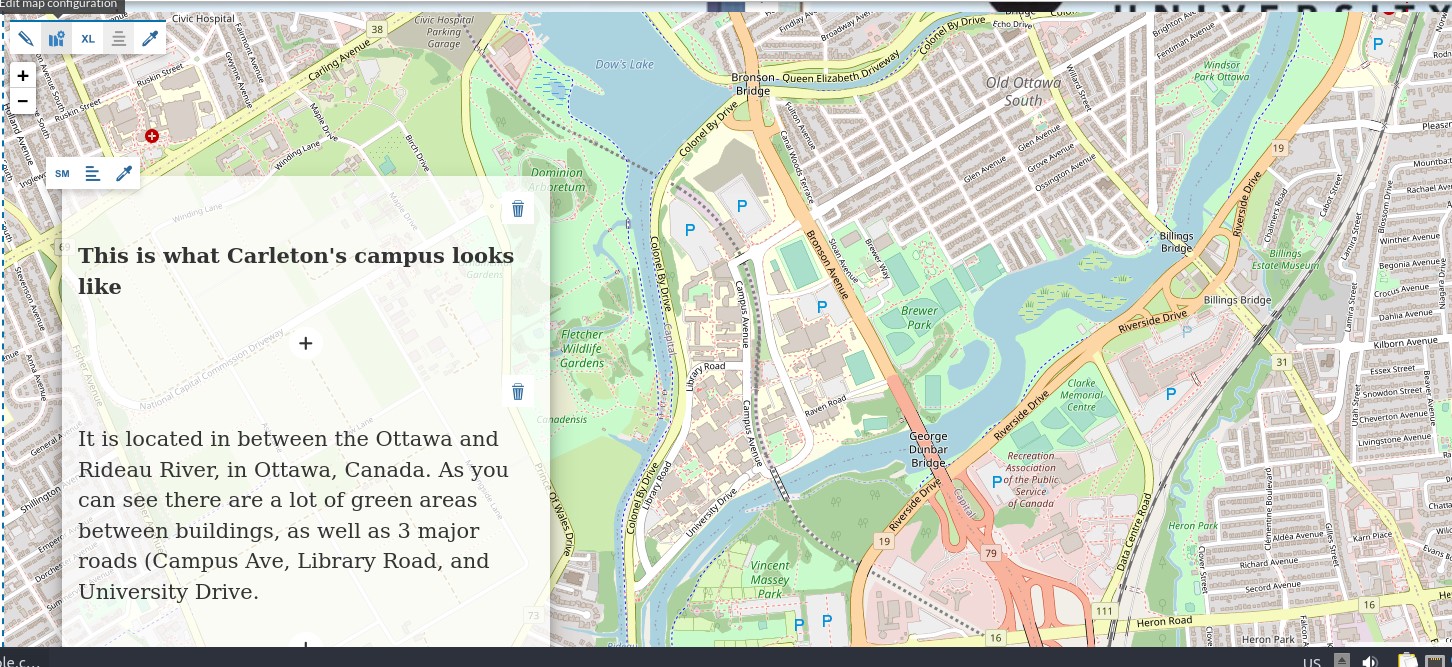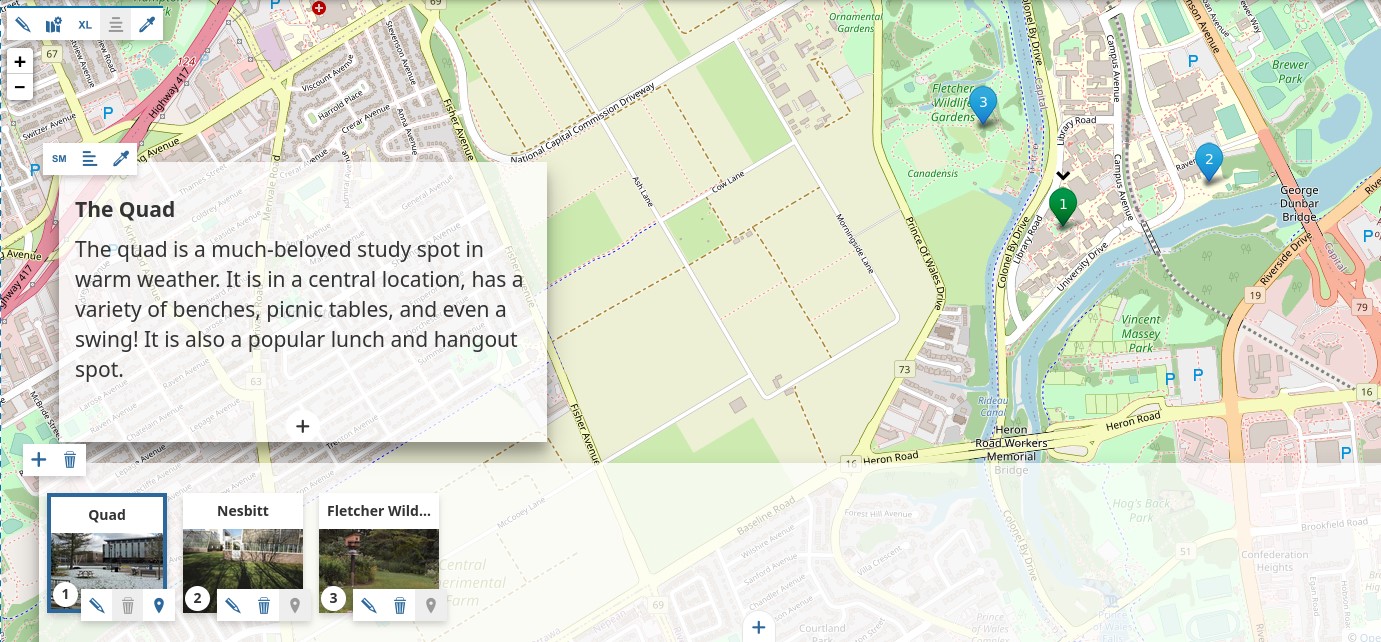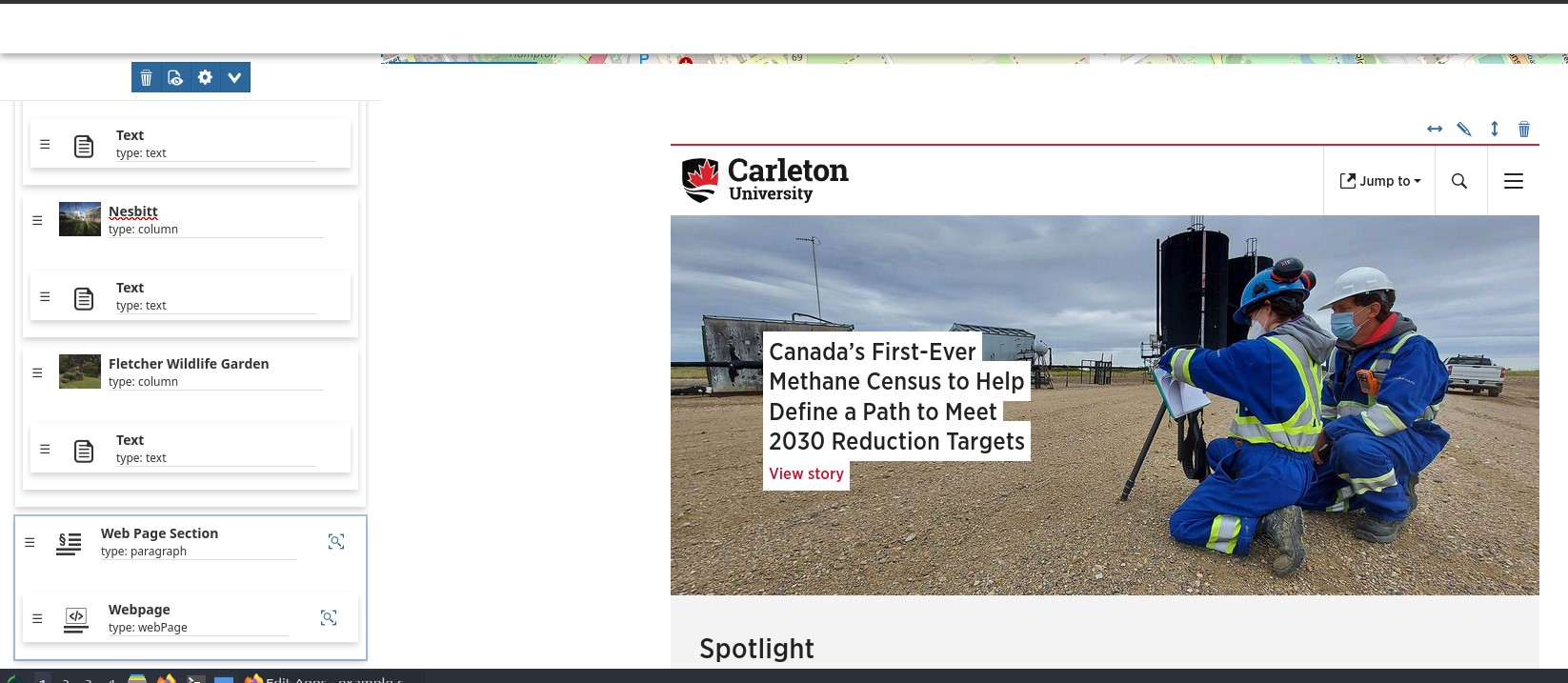Creating a Geo Story using GeoNode and GeoStory
Contents
Introduction
This tutorial introduces GeoStory, a GeoNode product, and goes through all of the basic functionalities of the product to create a usable, sharable web-based GeoStory. This includes installation and startup, creating base maps, addings media, immersive, and geocarousel sections, and sharing. For a more in-depth introduction to GeoNode, see the CUOSG tutorial: Creating a map using GeoNode and QGIS Tutorial.
Story maps are maps integrate cartography and story-telling into one product, which enables the use of maps for information sharing as well as narrative. They can be very useful tools to learn to use as they can convey complicated information in easy-to-grasp and engaging ways, for uses in everything from educating people on a specific topic to inspiring change to simply describing an area. GeoStory is a free, open-source alternative to the highly popular 'Story Maps' product by ESRI. It has some of the same major functions and can accomplish a similar outcome.
This tutorial goes through the main basic functions of GeoStory in the context of Carleton University outdoor study spots and other Carleton-specific applications. For further information on story maps and links to other tutorials, please see the References and Resources section at the bottom of this wiki page.
Installation and Setup
For the purposes of this tutorial, the Oracle VM Virtual Machine box, downloaded via the GEOM 4008 course was used, as it is already all set up with GeoNode. If you are not registered in this course and would like to follow along with this tutorial, you can download it using the following instructions from the GeoNode webpage: GeoNode quick installation guide.
Once the machine has been powered up, go to other > GeoNode, and start it up. You will then need to create an account (top right). You are now all set up to start the tutorial!
Tutorial
Creating an App and title page
To start, click on the 'App' dropdown menu, select 'create new app'. This is what GeoNode calls their GeoStories.
An app will automatically open, with a title section created. Immediately save your project. GeoStory does not auto-save, and will sometimes reload randomly, so remembering to save frequently is essential.
You can customize the background of the title slide to have an image by clicking on the pencil (edit media element) icon, clicking image, and then pasting the URL to an appropriate image. Note that to paste in the VM Box you need to have copied from a browser also within the box. You can use the same workflow to insert a video as well, by selecting video instead of image.
Adding an immersive section
To add a map to your app, you will actually need to exit the app to create one from scratch. Save your project, then go to the ribbon > maps > create map. You can then zoom and pan the world map to get to an area of interest, ensuring the entire area needed is within the frame. Then you can to go the top right and click save as. Name your map something descriptive.
Now that you have a map created, you can go back to apps, find your app, click on it, and select edit to return to the GeoStory editor. Pan back down to the immersive section you were working on. You are now able to add a map to the map by clicking on the pencil (edit media elements) > maps. Note that your map does not appear. Change the search section in the top right of the panel to GeoNode (not GeoStory, which only shows maps currently in the app). It should now appear and you can select it and hit apply.
Now that the map is inserted, you can pan it, zoom it, add a title (play with fonts, sizes, colours, backgrounds, etc), change the configuration and size, etc.
Adding a Geocarousel section
Geocarousels are the most well-known types of GeoStories. They are essentially interactive map slideshows. To add one, click the plus sign at the bottom of the app, select geocarousel. It know appears (empty), and prompts you to add a background map. Use the same one as previously, or go back to maps to create a new basemap. You can zoom or pan as needed.
The bottom panel (empty) shows the individual carousel items. Click on the map marker icon (bottom right) to pick the location of the first icon. You can now select where on the map you want it to be. Then, click the X to get back to the map, and edit the text frame to match that marker. Note that the text only corresponds to the marker currently selected (active). You can also click the marker to add a thumbnail and edit the title. Add as many markers as you like, and be sure to save often.
Adding a web page section
You can also select add a web page section, and have an up-to-date live view of any webpage by simply adding in the URL to it.
Adding a media section
You can also add a media section with another map, image or video, and complementary text. Here, a video was added by pasting the URL.
Viewing and sharing the final GeoStory
Once you are happy with your GeoStory, save it, then exit back to apps > view apps. It should appear and you can edit the title and upload a thumbnail.
You can then share it how you choose. BETTER INSTRUCTIONS.
The video below shows a scroll through the created basic GeoStory.
ADD VIDEO FILE
Conclusion
In this tutorial, you have learned how to:
- Install and setup GeoNode and GeoStory
- Create a custom basemap in GeoStory
- Create basic title, media (image, video or map), immersive and carousel sections in a GeoStory
- Share a completed GeoStory
References and Resources
GeoNode. (2020). Geonode users guide. GeoNode Users Guide - GeoNode master documentation. https://docs.geonode.org/en/master/usage/index.html
- The official GeoNode documentation, includes detailed installation instructions, information on different functions, and QGIS compatibility notes. A great reference for further reading.
MapStore. (2023). Geocarousel section. https://docs.mapstore.geosolutionsgroup.com/en/latest/user-guide/geocarousel-section/
- A great and highly detailed reference for information on each of the main categories of page type GeoStory supports, including examples of all.
Creating a map using GeoNode and QGIS
- Another CUOSG wiki for more information on GeoNode and QGIS compatibility and functions.








